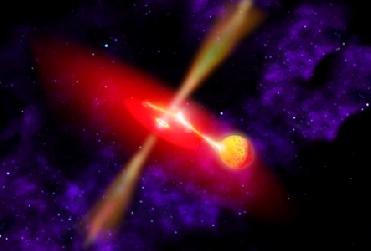
Swift X-ray observations of galaxy NGC 5408 indicate its ultraluminous X-ray source undergoes periodic changes every 115.5 days. This cycle, astronomers suspect, is linked to the orbit of a donor star around a middleweight black hole. Image Credit: NASA
NEW DELHI (BNS): Astronomers searching for evidence of black holes with intermediate masses said ultraluminous X-ray sources (ULXs) in galaxy NGC 5408 represents one of the best cases for a middleweight black hole to date.
"ULXs are good candidates for intermediate-mass black holes, and the one in galaxy NGC 5408 is especially interesting," said Richard Mushotzky, an astrophysicist at the University of Maryland, College Park. The galaxy lies 15.8 million light-years away in the constellation Centaurus.
Using the European Space Agency's orbiting XMM-Newton observatory, Strohmayer and Mushotzky studied the source -- known as NGC 5408 X-1 -- in 2006 and 2008.
"Intermediate-mass black holes contain between 100 and 10,000 times the sun's mass," said Tod Strohmayer, an astrophysicist at Goddard.
“We observe the heavyweight black holes in the centers of galaxies and the lightweight ones orbiting stars in our own galaxy. But finding the 'tweeners' remains a challenge."
Several nearby galaxies contain brilliant objects known as ultraluminous X-ray sources (ULXs). They appear to emit more energy than any known process powered by stars but less energy than the centers of active galaxies, which are known to contain million-solar-mass black holes.
XMM-Newton detected what the astronomers call "quasi-periodic oscillations," a nearly regular "flickering" caused by the pile-up of hot gas deep within the accretion disk that forms around a massive object. The rate of this flickering was about 100 times slower than that seen from stellar-mass black holes. Yet, in X-rays, NGC 5408 X-1 outshines these systems by about the same factor, a NASA statement said.
Based on the timing of the oscillations and other characteristics of the emission, Strohmayer and Mushotzky conclude that NGC 5408 X-1 contains between 1,000 and 9,000 solar masses.
With the help of NASA's Swift satellite they searched for subtle variations of X-rays that would signal the orbit of NGC 5408 X-1's donor star. "Swift uniquely provides both the X-ray imaging sensitivity and the scheduling flexibility to enable a search like this," he added.
Beginning in April 2008, Swift began turning its X-Ray Telescope toward NGC 5408 X-1 a couple of times a week as part of an on-going campaign. Swift detects a slight rise and fall of X-rays every 115.5 days. "If this is indeed the orbital period of a stellar companion," Strohmayer said, "then it's likely a giant or supergiant star between three and five times the sun's mass."
 Previous Article
Previous Article Next Article
Next Article













The Indian Air Force, in its flight trials evaluation report submitted before the Defence Ministry l..
view articleAn insight into the Medium Multi-Role Combat Aircraft competition...
view articleSky enthusiasts can now spot the International Space Station (ISS) commanded by Indian-American astr..
view article